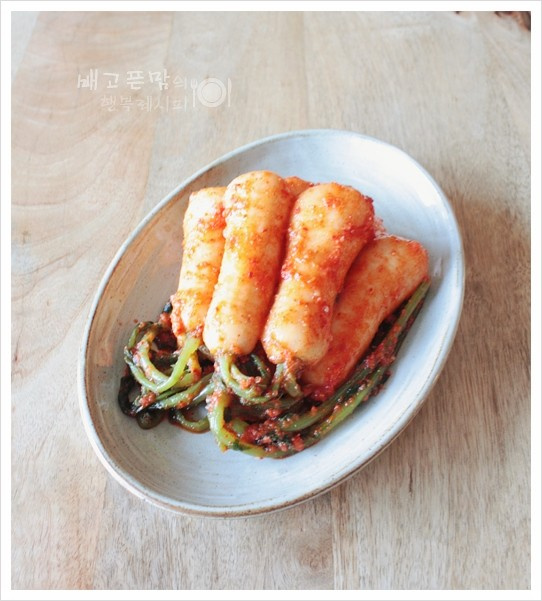Crispy and Delicious Chonggak Kimchi (Radish Greens Kimchi)
Chonggak Kimchi Recipe: Enjoy the Crispy Texture and Deep Flavor

This is a recipe for homemade Chonggak Kimchi, also known as Altarimchi. Even with two bundles of altarim, you can create delicious kimchi. This recipe covers detailed steps from preparation to seasoning, making it easy for beginners to follow. Enjoy a flavorful meal with this crispy and deeply flavored Chonggak Kimchi!
Kimchi Ingredients- 2 bundles Altarim (young radish greens)
- 3/4 cup coarse sun-dried salt (for brining)
- 15 Tbsp Gochugaru (Korean chili flakes)
- 1 Onion
- 16 cloves Garlic
- 1 piece Ginger
- 15 Tbsp Fish Sauce
- 3 Tbsp Salted Shrimp
- 3 Tbsp Plum Extract
- 3 Tbsp Cooked Rice
- 1 cup Dried Anchovy and Kelp Broth
Cooking Instructions
Step 1
First, wash the altarim thoroughly to remove any dirt. Before peeling, rinse the altarim under running water to gently wash off the soil. You don’t need to scrub them intensely; just ensure no dirt will stick to the radish as you peel.

Step 2
While a peeler is convenient for the radish skins, I prefer using a paring knife to scrape them off. Start from the top where the greens are attached and gently scrape downwards with the knife to peel the altarim. This method helps preserve the fresh flavor.

Step 3
After peeling, remove any yellowed or wilted parts of the greens. Trim the largest leaves at the very top and then wash the greens again under running water until clean.

Step 4
After preparing two bundles of altarim, you’ll notice they vary in size. Don’t worry about the inconsistent sizes; it actually adds an interesting texture variety when the kimchi is fermented.

Step 5
Cut the smaller altarim in half lengthwise. For the larger ones, cut them into quarters lengthwise. This consistent cutting helps the seasoning penetrate evenly, resulting in a more flavorful kimchi.

Step 6
In a large bowl or kimchi container, place a layer of the prepared altarim. Sprinkle a small amount of coarse sun-dried salt over the layer with your fingertips, ensuring even distribution. Continue layering the altarim and sprinkling salt. It’s important for the salt to get between the radish pieces.

Step 7
Use 3/4 cup of coarse sun-dried salt to brine the two bundles of altarim. Brine for a total of 1 hour and 30 minutes. During this time, flip the altarim once or twice to ensure even salting and to maintain their crispiness.

Step 8
Check the condition of the altarim after they have been brined for 1 hour and 30 minutes. They should be somewhat softened yet still retain a crisp texture, indicating they are perfectly brined.

Step 9
Rinse the well-brined altarim twice under cold running water. After rinsing, drain them thoroughly in a colander. Removing as much excess water as possible is crucial to prevent the kimchi from becoming mushy and to keep it fresh for longer.

Step 10
Place the drained altarim in a large bowl and sprinkle 15 tablespoons of gochugaru (Korean chili flakes) evenly over them. Gently toss the altarim with the chili flakes to coat them. This pre-coating helps the seasoning adhere better and gives the kimchi a beautiful color.

Step 11
Now, let’s prepare the flavorful seasoning paste. In a blender, add one onion cut into large chunks. Add 16 cloves of garlic, halved, and one piece of ginger, finely chopped. Ginger is essential for removing any unpleasant odors and adding a wonderful aroma.

Step 12
Add 15 tablespoons of fish sauce, 3 tablespoons of salted shrimp, and 3 tablespoons of plum extract to the blender. This mixture creates a balanced seasoning base with umami, sweetness, and depth. Blend all ingredients until smooth.

Step 13
Pour the smoothly blended seasoning paste over the altarim that have been pre-coated with gochugaru. Ensure the seasoning is spread evenly across all the altarim pieces.

Step 14
Using the same blender where you made the seasoning, add 3 tablespoons of cooked rice. This helps to scrape off any remaining seasoning stuck to the sides of the blender.

Step 15
Pour 1 cup of dried anchovy and kelp broth into the blender with the rice. Blend until smooth. This process creates a rich and flavorful kimchi paste without needing to make a separate glutinous rice paste (chapssal), and the blended rice provides a smooth texture to the seasoning.

Step 16
Pour the blended rice and broth mixture over the altarim. This addition will give the kimchi a refreshing taste and deep umami flavor.

Step 17
Now, use your hands to gently mix and coat the altarim evenly with the seasoning. It’s important to ensure every piece of altarim is well-coated with the seasoning for the best flavor. Pack into a kimchi container and let it ferment to enjoy its delicious taste!



